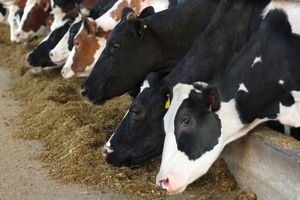Integrate The Right Level Of Dairy Revenue Protection
Editor’s Note: This is the second in a two-part series about Dairy Revenue Protection. Miss the first article? Catch up here.
 When the U.S. Department of Agriculture (USDA) Risk Management Agency (RMA) created Dairy Revenue Protection, it became a key component of risk management strategies for producers and their industry partners. Entering its third year, there are some key changes in the program that may affect how producers integrate it into their operations.
When the U.S. Department of Agriculture (USDA) Risk Management Agency (RMA) created Dairy Revenue Protection, it became a key component of risk management strategies for producers and their industry partners. Entering its third year, there are some key changes in the program that may affect how producers integrate it into their operations.
How does DRP class or component pricing work?
Though producers sign up on a quarterly basis, Dairy Revenue Protection (DRP) coverage and premium prices are based on monthly CME Group average contract prices. Coverage is based on milk class (III or IV) or components (butterfat, protein, other solids). The right level depends on dairy size, production costs and products marketed.
“The original intent of class pricing was allowing producers the opportunity to get close to what their actual price would be. I think they probably purchase based on their break-evens versus what their price would be,” said ProAg Western Region Senior District Manager, Jacqueline Da Rocha. “Usually, with component pricing, insureds are milking Jersey cows, producing higher component levels. Component pricing is more for those herds producing higher component levels, while class pricing is used more for producers who are producing as much fluid milk as they can.”
What are the DRP premium structures?
Dairy Revenue Protection premiums, for which producers can receive a subsidy of up to 55%, range based on resulting liability exposure. Finding the optimal balance between coverage level, premium and available subsidy is often the best way to determine what will be best for each quarter of DRP coverage. “If you need to cover your costs, what is the market price you need to reach?” Da Rocha said, adding 95% is the most common DRP protection level. “Some producers say the difference between Class III and Class IV milk doesn’t matter because they see all the volatility in one class. Or they may protect only specific components if they’re doing component pricing. It’s really about protecting the prices they need to maintain to continue to operate.”
Are there changes to DRP in the 2021 crop year?
Dairy Revenue Protection saw a few changes this year. In the past, only Grade A milk could be insured. Starting in the 2021 crop year, Grade B milk, used in cheese, butter and nonfat dry milk — is eligible for DRP coverage. Updates also include a wider range of insurable product butterfat and protein levels and also for component pricing, a weighting factor option and nonfat solids price.
Responsible marketing and risk management strategies will remain important, according to Da Rocha. These changes recognize industry improvements in output quality, but it remains important to actively manage risk to preserve revenue opportunities.
“We will continue to see mostly class pricing, but as we move through the year, depending on the market conditions and premium costs associated with them, the more liability you have and more volatile the markets are, the more you will have to take notice and determine the right protection levels.”
Take the guesswork out of DRP management
Dairy producers and their agents have a helpful tool to manage their DRP policy in the myProAg™ portal. Here they can access policy information and daily market prices that will contribute to future quarters’ DRP premium costs.
“The producer can go in and save their information; which quarters they’re interested in enrolling in DRP, how much milk and butterfat levels they want to protect and a general idea of what that protection will cost,” Da Rocha said. “There are always different variables like feed quality and calving cow numbers, so production numbers can change, but you can get an idea of cost per CWT of production. The quote tool at my.ProAg.com can help take a lot of guesswork out of the DRP component to provide a consistent, comprehensive risk management strategy.”
Log on to my.ProAg.com to get a DRP quote today. Do you have questions? Contact your ProAg agent or nearest ProAg regional office.
